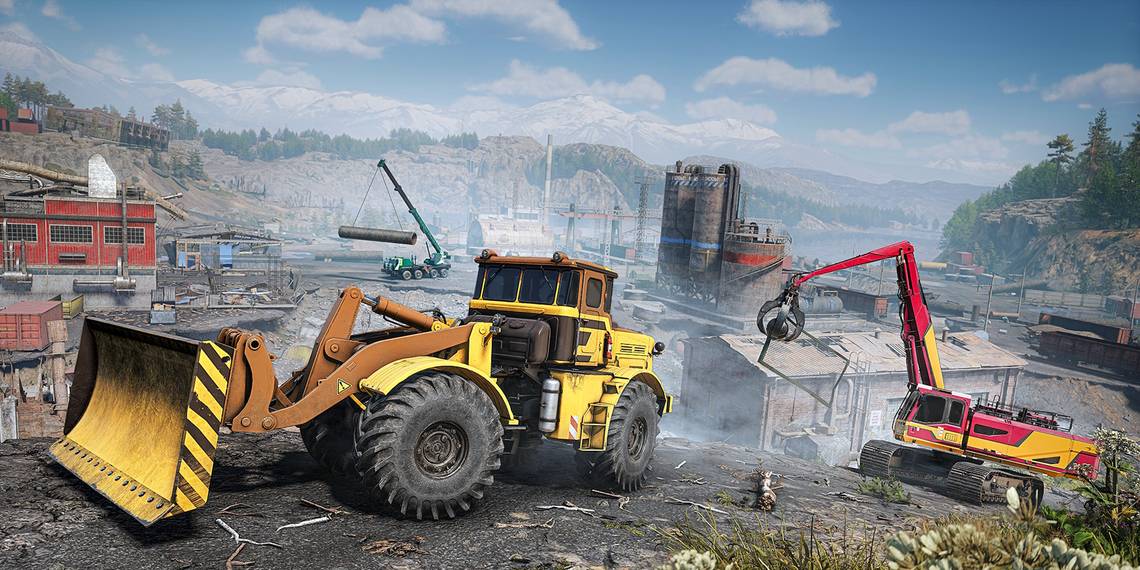
A storm has hit, devastating an area. Flooding, debris, and destroyed buildings dot the landscape, and things look dire. As soon as the storm clears, everyone wants to try to get back to some semblance of normalcy, but there’s one part everyone forgets – you have to be able to reach things to repair them. RoadCraft focuses on that reachability aspect of disaster recovery, emphasizing incremental improvements as you try to restore critical infrastructure. Up to four players roll out in a massive sandbox of reconstruction challenges, rebuilding roads, pumping out flooded areas, repairing pipes, replacing generators, and so much more. This isn’t a new concept for developer Saber Interactive, but can RoadCraft be more than just an iteration to their previous efforts, SnowRunner and MudRunner? Time to put on our construction hat and find out.
After naming your construction company and deciding on a logo and truck colors, you’ll be dropped at the edge of a devastated area with the increasingly challenging task of restoring services. Scouting the space with my truck, I see that reaching my repair sites will be a challenge as the roads have devolved into mud pits at best. Like the name suggests, you’ll be spending a good bit of time crafting roads for your heavy equipment to get from here to there, punctuated by a bit of construction and restoration. Success expands the map, bringing new primary and optional side objectives as you work to rapidly get the area back in business. In concept it’s a brilliant iteration to the well-laid groundwork of Saber’s previous work. In practice, we’ve gotten stuck in the mud more than a few times.
Just about everything in RoadCraft hinges on the newest item in the series’ toolbox – an improved physics engine. Powered by a new version of the vaunted Havok engine, vehicles lumber through the environment, carrying materials to their intended destination to facilitate repairs. Since it’s such a central aspect of the game, let’s talk through the process of building roads, and how physics come into play.

For example, a road has been washed out. Your tracked vehicles can slog through it, but your heavier specialty vehicles are going to be in trouble quickly, sunk to the axle. Finding a nearby sand quarry, you can load up a dump truck with sand to help shore it up. Tipping sand onto the top of the muddy mess, you can see the sand spread realistically, taking up the space with a volumetric spread. Using the sand spreader function on your grader, you can then flatten the sand with the blade, squeezing the excess sand off the edge and creating a relatively flat surface. This will work pretty well for most vehicles, but if you want something more permanent, you’ll bring in a vehicle to drop a layer of asphalt on top of the sand, followed by a roller to compact it down into a semi-permanent new road. More than merely cosmetic, there are a number of complex calculations occurring under the hood, and the end result is a road that will hold up to long-term repair operations. Well…mostly.
Using a crane vehicle as a similar example, you’ll be tasked with repairing pipes that might have storm damage or transporting a heavy generator or pump. Deploying outriggers, the vehicle shudders into a locked position, lifting from the ground slightly to add stability. Reaching out with the boom arm, you can pop the damaged pipe loose, drag it out of the way, and then affix a new pipe in its place. Without outriggers, you might find yourself unstable, tipping over the truck and causing a whole heap of trouble.
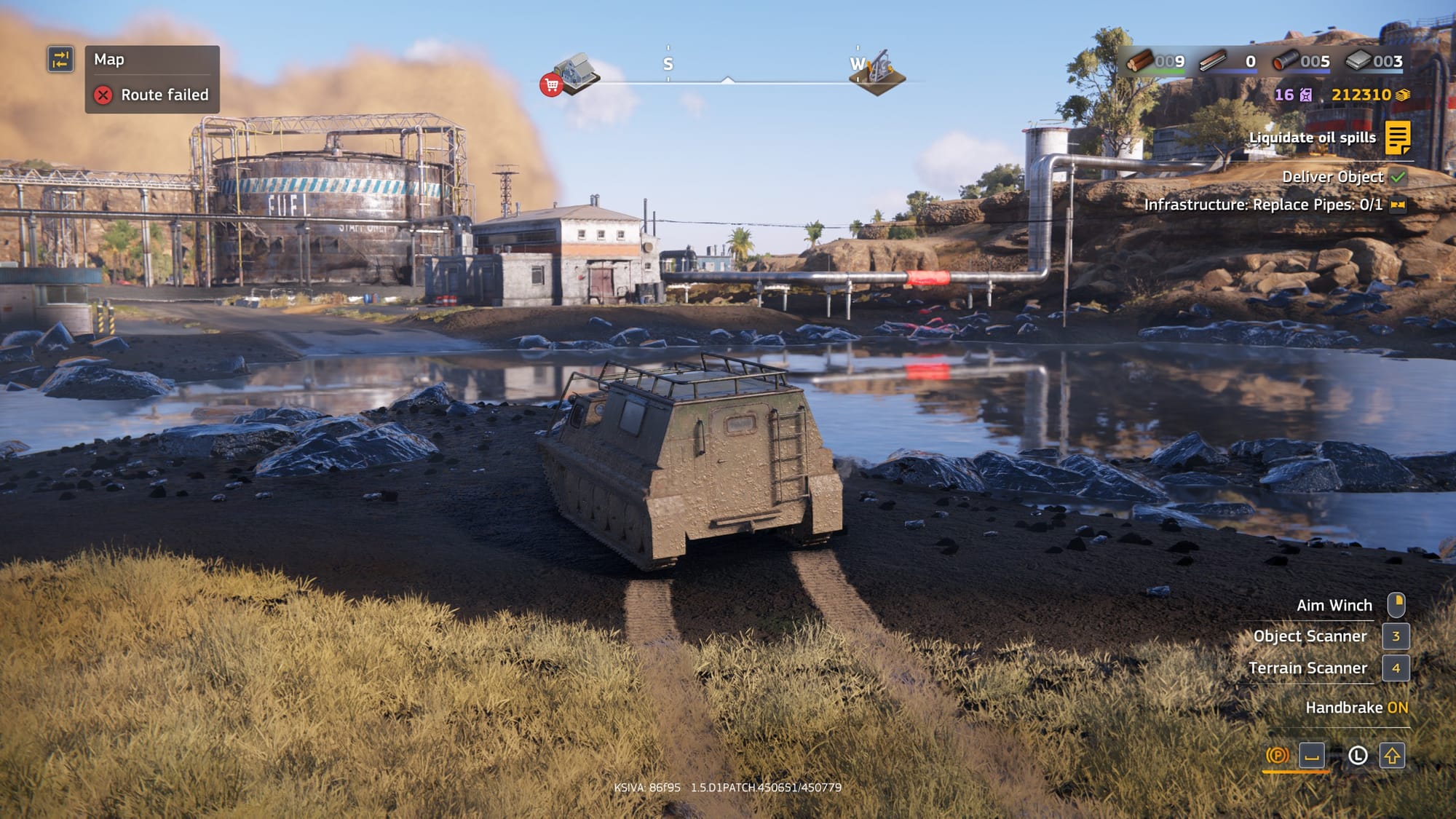
In both cases, the underlying physics engine powers that “sunk to the axle” mud pit part, determines ground deformation, how much wobble a vehicle suffers as it carves through it, and the positional magnitude of how the vehicles press down on the aforementioned mud and sand, as they dig their tires in. It also determines how much the blade you used to spread it can cause that sand to slide off the edge and slowly fill up the water-filled hole adjacent to it. It’s more than cosmetic, and it’s impressive the vast majority of the time. Every once in a while the game asks you to try to find an easy route, but you might want to simply fill in an entire Grand Canyon-like pit with sand just out of spite. Have I done that a few times? You bet. The great part is that the game supports it.
It was the dawn of 3D when we first started seeing physics-based bugs. The scene switches, everyone’s clothing “jumps” for no particular reason, and the scene moves on. It’s a problem that’s been with us for more than two decades at this point. As physics-based materials became the norm, this odd behavior began to extend to physical objects in the scene. Ragdoll enemies wiggled in bizarre ways, destroyed objects shuddered and then flew around the room. Now we can add “semi trucks take flight, never to return” to the list. There are a few trucks in RoadCraft that are no-go, even a month after the launch of the game. One truck is meant to haul very large equipment across the map, able to allegedly hold multiple vehicles. I say “allegedly” as the half dozen times I’ve attempted to use it, it has suddenly shot off like a bullet, spinning around in the sky at 10,000 feet. You can jump into the cockpit, but recovering the vehicle just causes it to respawn in the sky once again, or worse, crash the game entirely. At launch this affected two semi trucks, but now it's intermittent for just one. There are over 40 vehicles (and many coming on the roadmap ahead), but I'm happy to say that it doesn't seem to affect any others. That said, I have had my bucket loader suddenly grasp onto a light pole and start dancing around it like a construction-stripper, so bugs remain.
While the engine handles this “spin a semi into the sky” feature remarkably well, it only serves to underscore a design choice that I sincerely hope Saber fixes soon. The camera is just FAR too close. The visuals are pretty fantastic (and on PC there is a 4K texture pack if your pc can handle it), but most of the time the camera is so close that I struggle to see things around me. Backing up and putting your crane into the mud, then having to drive miles back to the construction area ruins the fun when it comes from something as simple as “I wasn’t able to move the camera far enough away to see behind me”. I know it’s not a performance issue as the game runs remarkably well on an older RTX 2080 Max-Q-powered laptop from several years ago at max detail, so I can’t rightly explain it. Free the camera, Saber!
While we’re on the topic of feedback, there are a handful of things that would take the game from good to great. When playing single player, if you are loading a piece of cargo with a crane into a flatbed truck and need to reposition that truck, the materials you have suspended are just dropped to the ground when you exit the truck. If it stayed put so I could move the truck, that’d reduce some build friction.
The biggest feedback I have ties directly to the game’s name – RoadCraft. You’ll be given objectives to pack sand, smooth, asphalt, and flatten out a full road a few times to teach you how to do it. In these moments you can hack your way through the controls (more on that in a second) to do all four of these activities in an entirely automated way, having the AI pave a road from start to finish. Or at least, pave a section of that road. You see, you have no mechanism to designate these activities for yourself. The automation is hard-keyed to an objective, meaning you can’t just paint a road and tell the AI “pave this” and turn them loose. Once you’ve built a few roads, you might want to turn over the simple ones to the AI to handle, working on the complex ones yourself. Sadly, that’s not an option. Similarly, having the AI pluck containers out of the way with an overhead crane is the sort of thing you should be able to “evolve” into after you learn how to do it manually, but you’ll be shoving debris around by hand from start to finish.
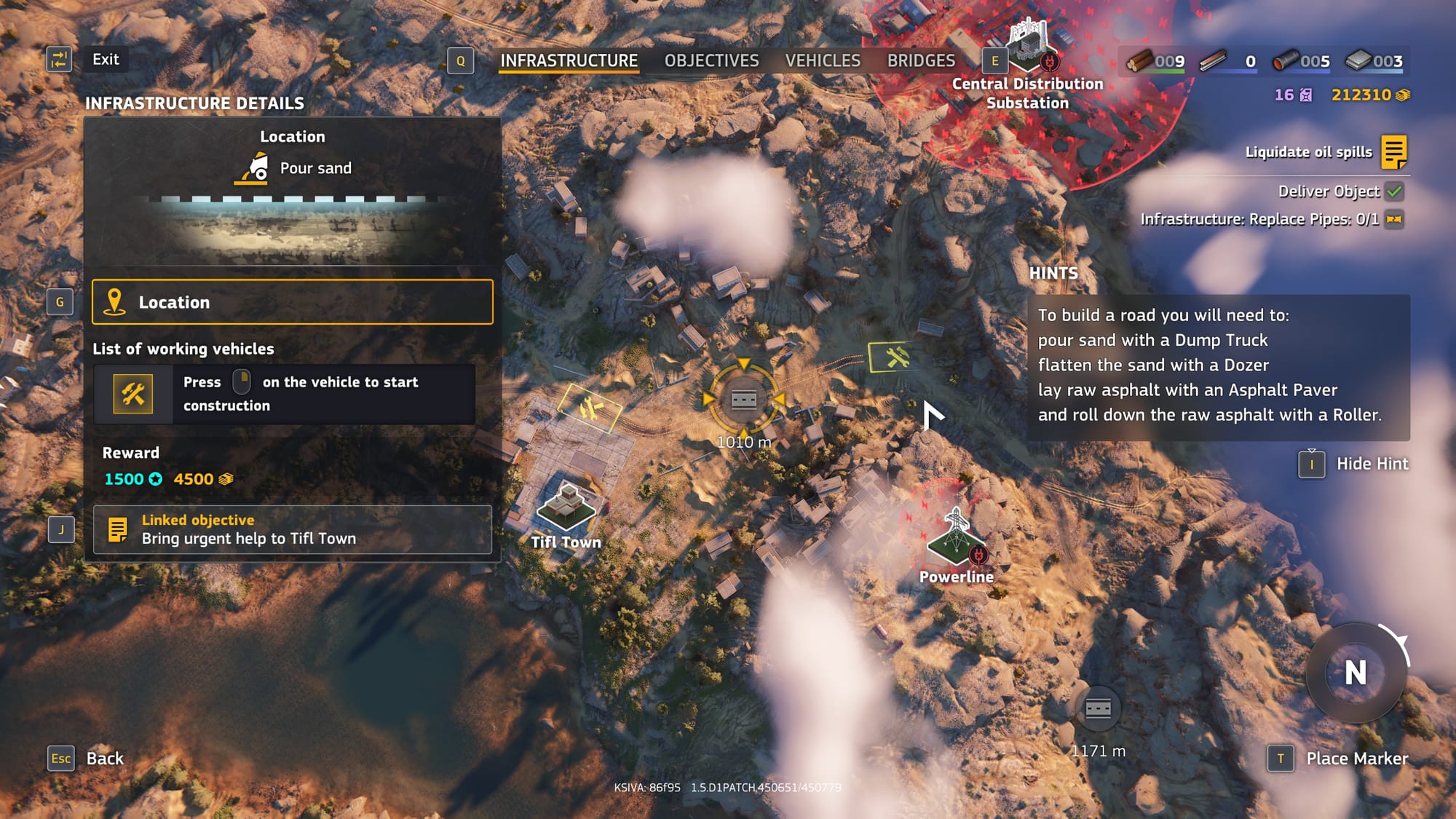
If my monitor was a CRT, I swear the phrase “route failed” would be burned into it at this point. When you establish a route for the automatic vehicles to transport materials from A to B (not that you get any benefit from these by the way – I swear whomever I’m working for is running a grifter scheme on my work), your vehicles will continue to try to follow that route. For whatever reason, the AI just…can’t. Despite being incredibly specific on how I’d like the trucks to proceed, they veer off course, get stuck in the mud, run into K-rails, and various other “fun” variations that cause the route to fail. Once you’ve collected up all of the resources this path has to offer, you’ll likely just leave it as failed as it offers no benefits, hence the permanent error on my screen. The ability to dismiss a route would help, or better yet, when the route is complete, just take it off for me.
Back to the controls, they aren’t bad, they are just easy to misunderstand. So much of the tutorial system is lacking or passed to you by text on the loading screen, sometimes recommending complex things before really giving you much guidance on how to accomplish them. ALL of these missions are open sandboxes with what appears to be the ability to tackle all of it in any order you’d like, and for the most part that’s true. That said, sometimes it feels like your construction company is just you and your friends. You spend a lot of time driving, then trying to figure out what the game wants you to do, then trying to figure out what nuance of the controls. There is an alternate control scheme for the cranes (the largest and most inconsistent of the control woes) that is pulled over from SnowCraft, but the game isn’t telling you this up front.
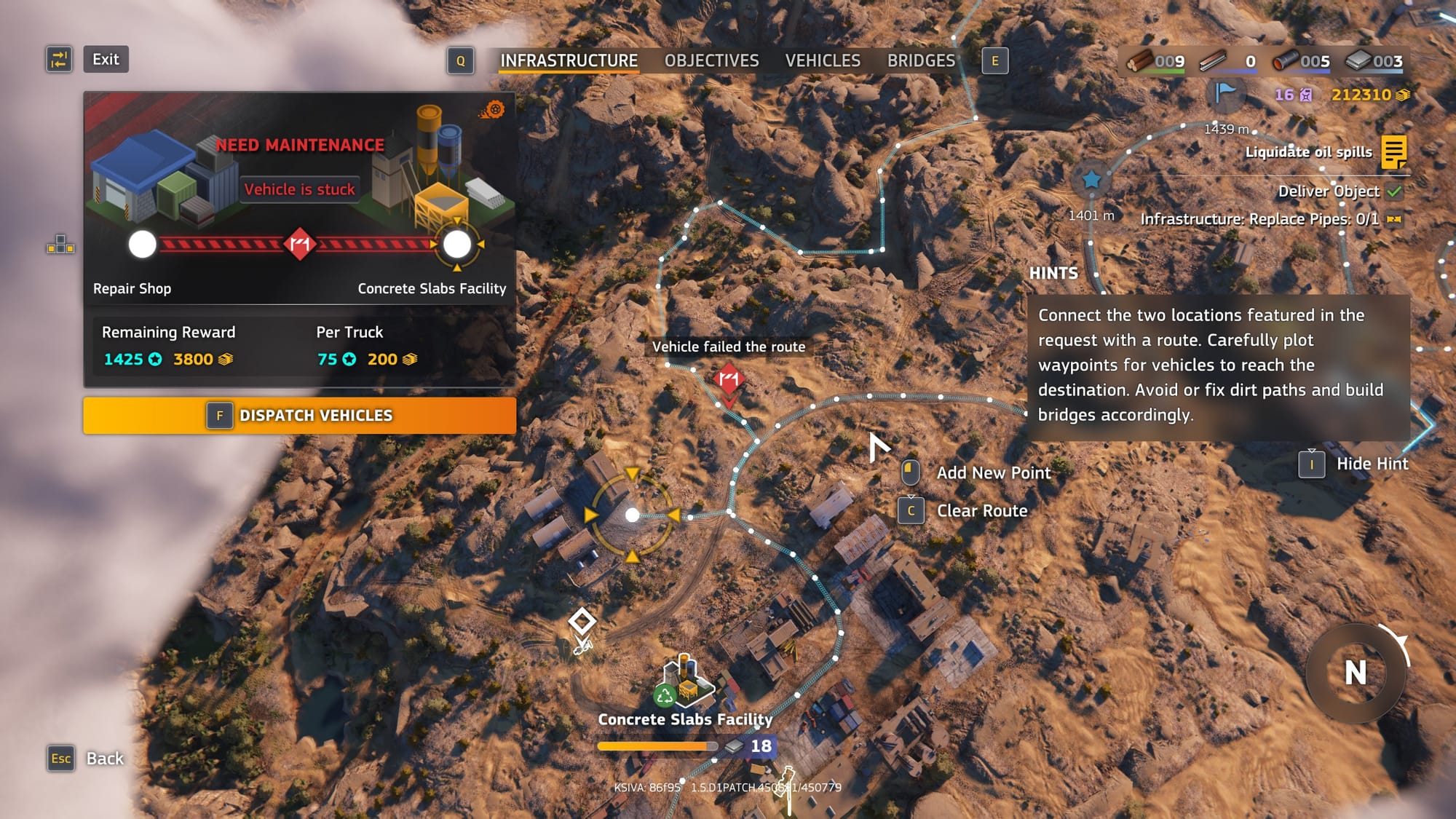
As you complete work, you’ll earn experience points and money. This XP culminates in levels that grant you access to more than 40 real-world pieces of heavy equipment. Dozers, graders, trucks, cranes, articulated dump trucks on tracks, semi-trucks (flying and otherwise), asphalt pavers and rollers, cranes big and small, all manner of logging gear, stump mulchers, cargo trucks (with and without pickers), vans, jeeps, cable layers, and so much more unlock over time. Each are broken down with capabilities – Stability, Mobility, Capability, Weight, and whether they do or do not have a low gear, all-wheel-drive, a differential lock, crane capabilities, or a winch. You start with a rusty version of most vehicles, but buying a new version will improve these stats. Sorry – no overhauls allowed, but you can sell the old one for cash you can then put towards the newer one.
The third resource you’ll earn is fuel. While there is no fuel consumption mechanic, you’ll use this fuel to respawn at a special vehicle called the KHAN Lo "Strannik". Based on the real-world Russian GAZ-3344-20 Aluet, this Field Service Vehicle is a resilient track-based vehicle that can get closer to the objective than other vehicles, allowing vehicles to then spawn off of it instead of at a garage. It’s useful when you aren’t near a garage location, but it does require fuel earned from completing side and main objectives. It prevents you from using them to “fast travel” across the map, though coupled with the vehicles that all seem to have an inner ear infection for how often they fall over, it’s annoying that it’s a finite resource – it makes it feel like a bandaid to a slightly busted system.
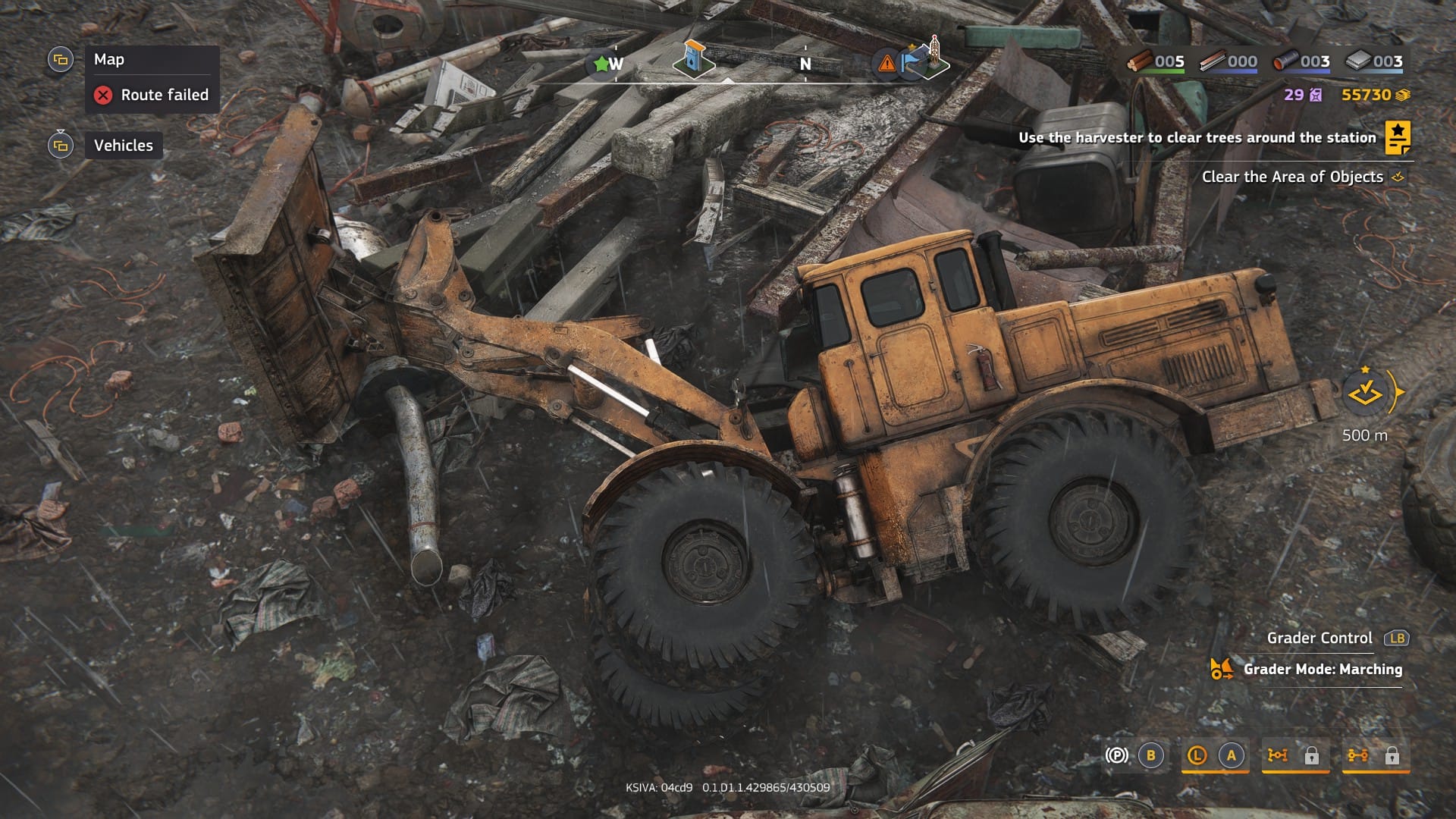
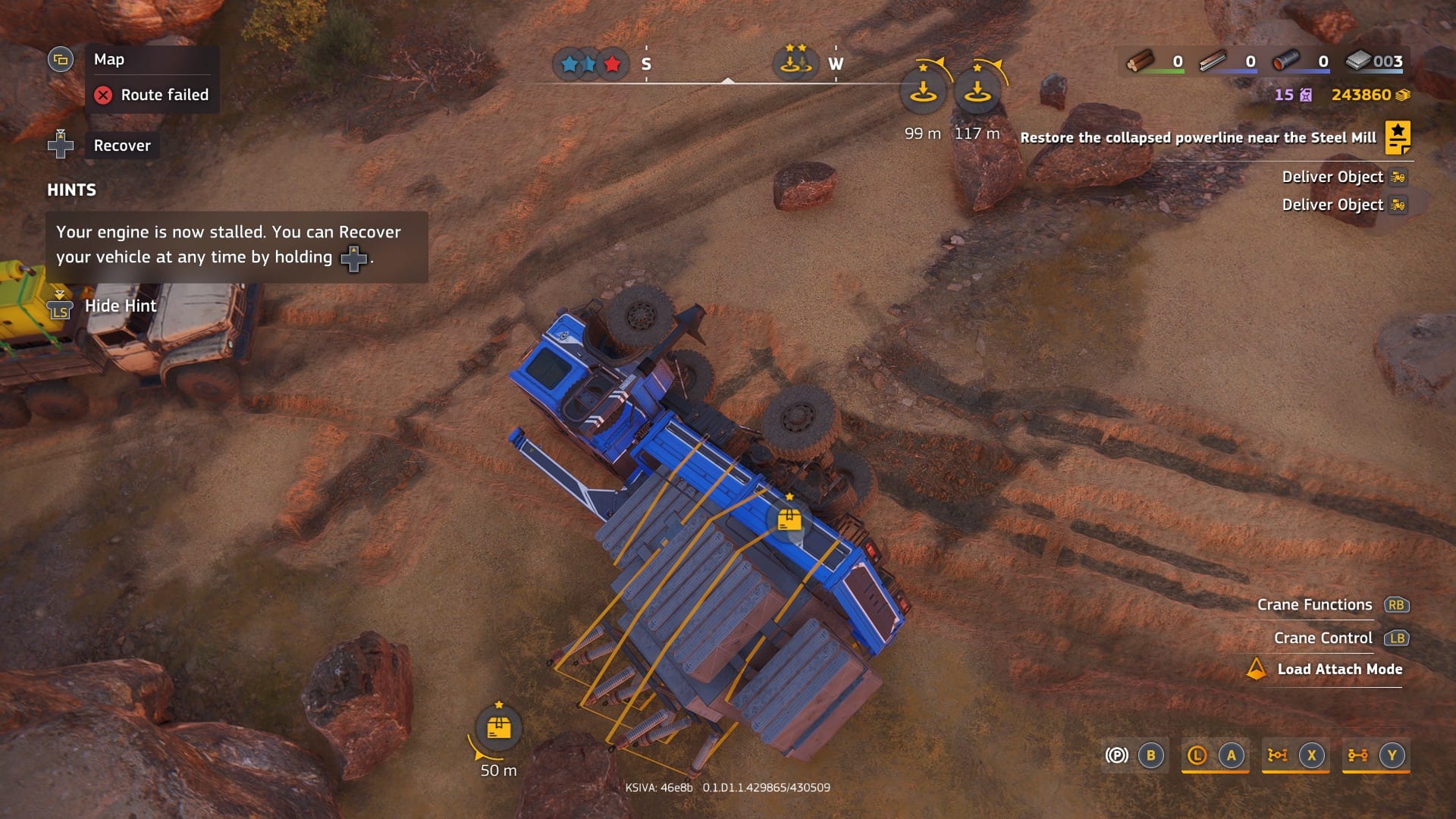

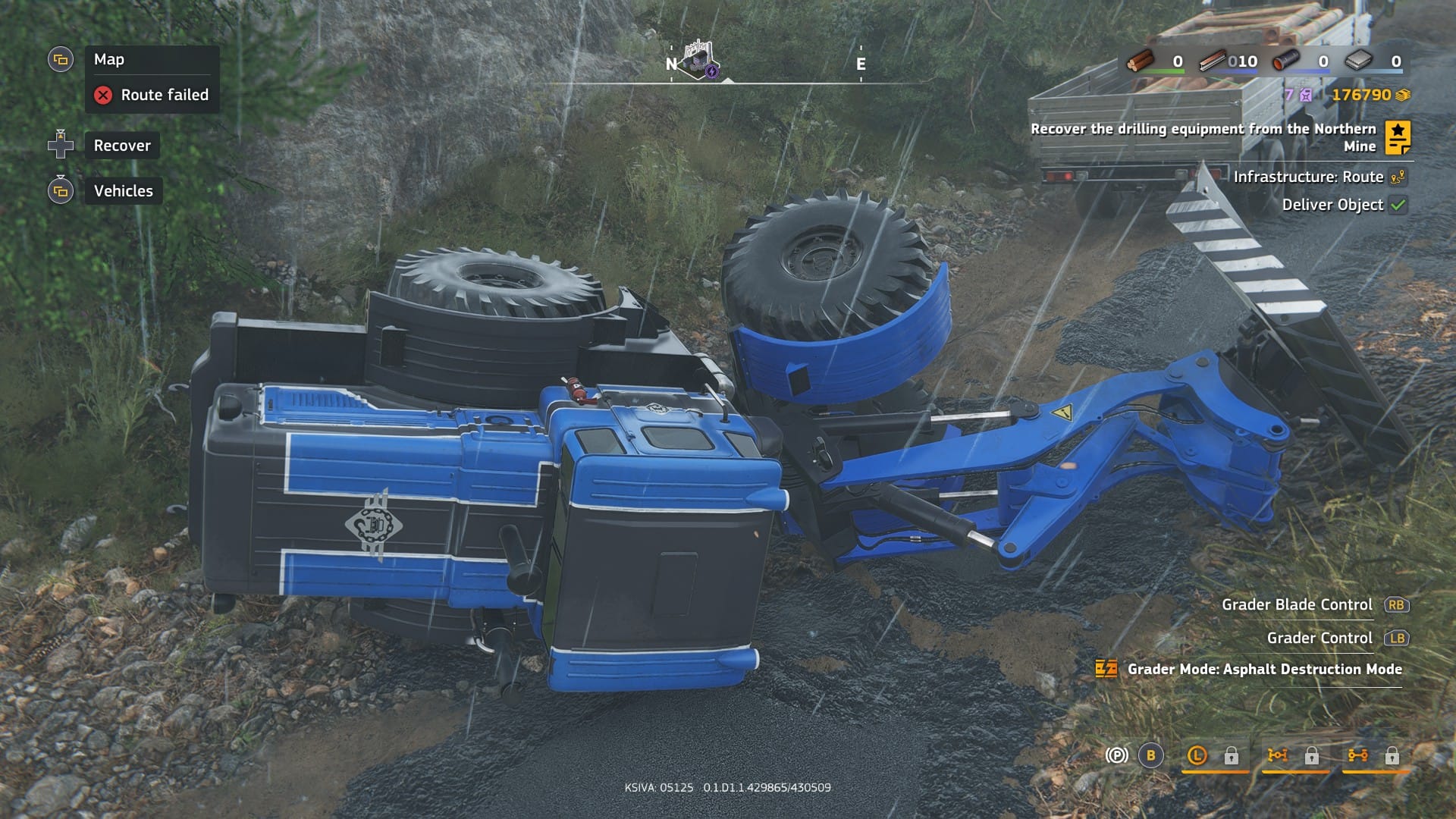
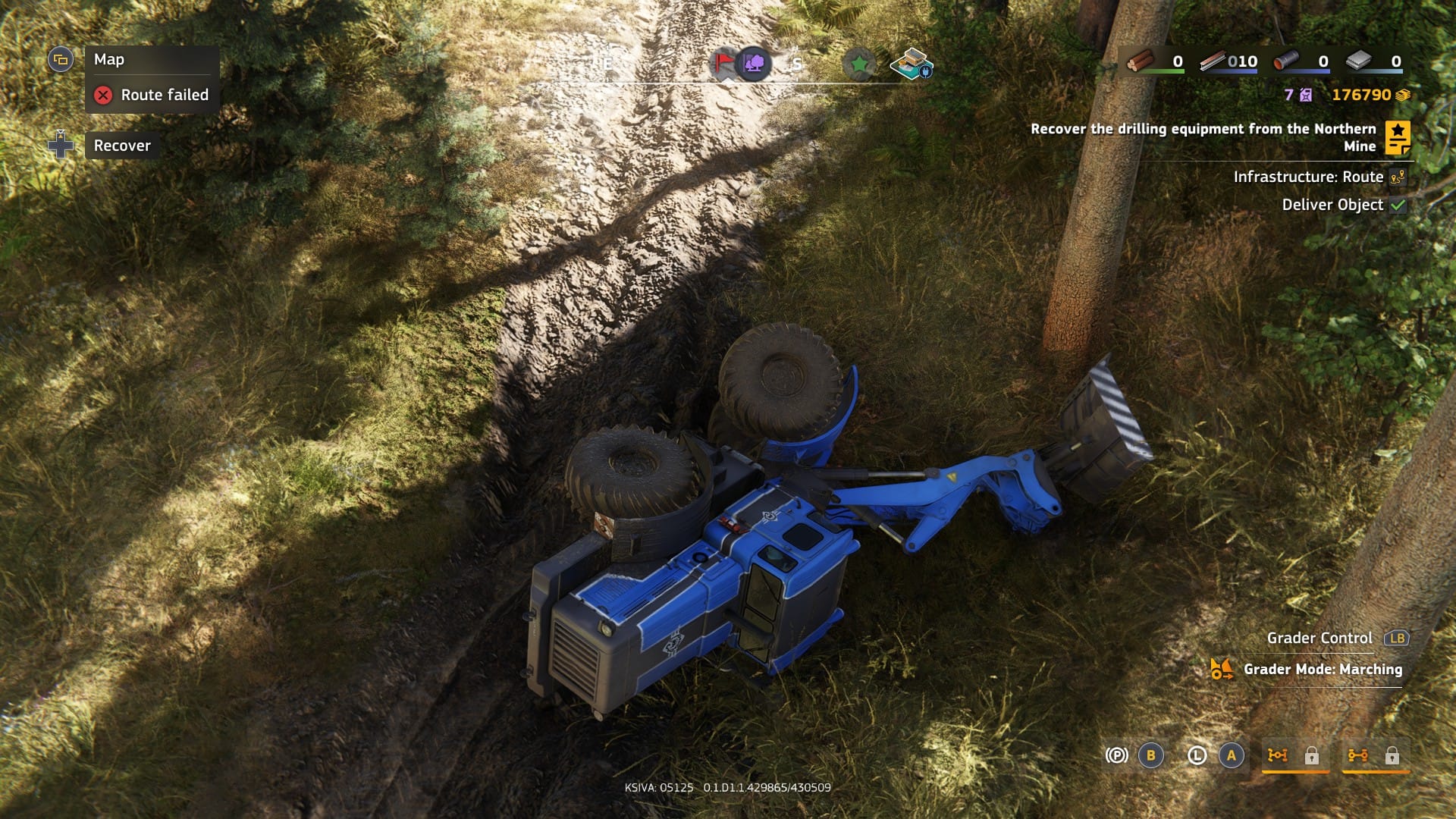


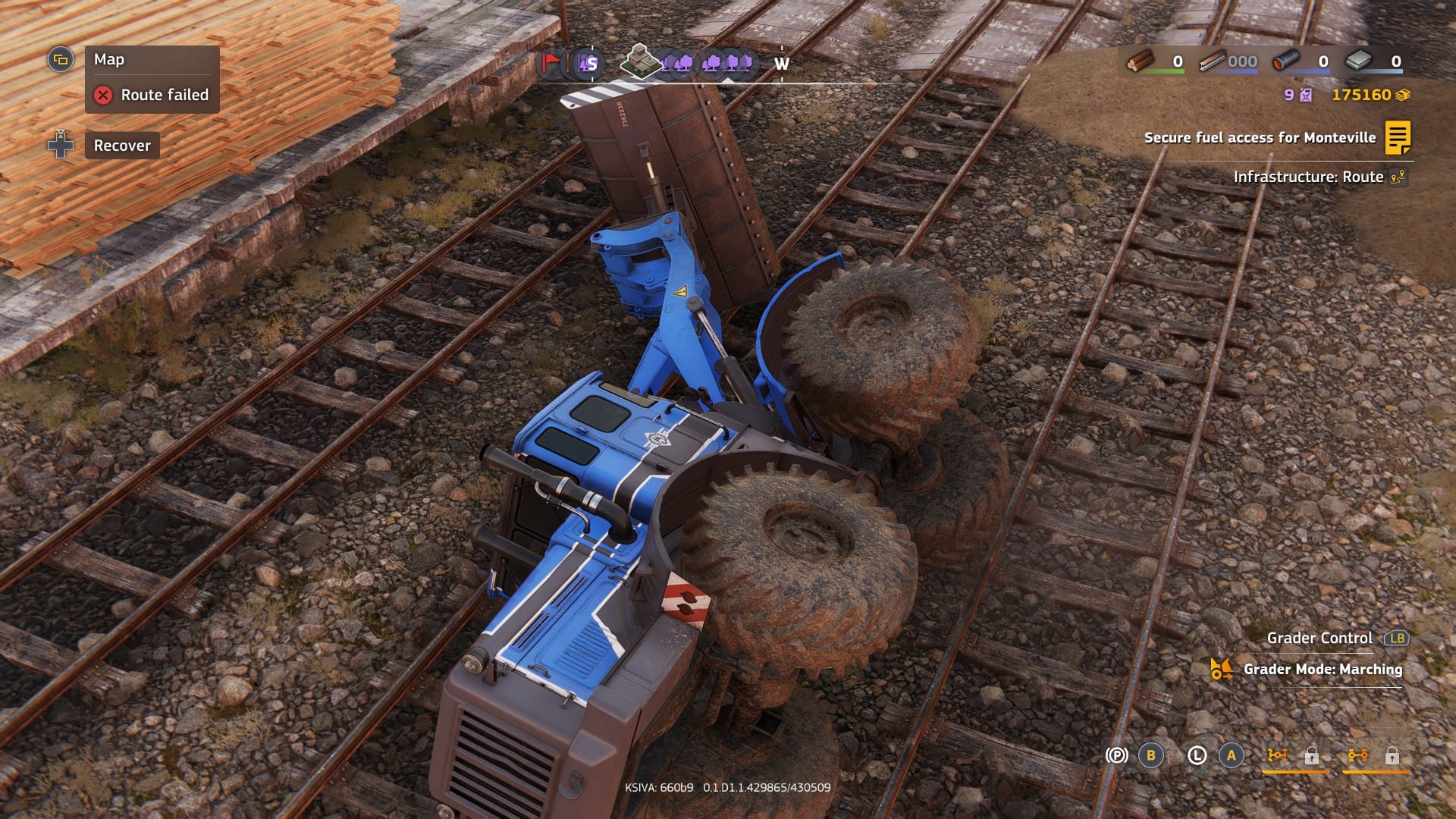

I'd like to welcome the Inner Ear Infection Construction Crew!
There are some odd decisions going on in RoadCraft that lead to a bit of swearing in my household. Trees that have fallen over a roadway are seemingly impossible to move, even with a 20 ton bulldozer. Similarly, a flooded out village with wooden debris everywhere can’t be bulldozed at all. Frankly, I have learned more from the loading screens than the game had to teach me via the tutorials. There are a number of nuances to some of the mechanics that just aren’t explained. You can sell off a bridge you no longer need for resources. New vehicles are better than rusty ones not only visually but also performance-wise, offering better handling and capacities. The salvage system is obtuse as all get-out. Pulling items out of storage, putting them into storage, recycling them, selling them, and buying them is a bit of a head scratcher as well.
The biggest issue with RoadCraft is that it just isn’t quite done cooking. All of the mechanics are here, the core gameplay elements are fun and compelling, and it’s easy to see how it’ll eventually come together. Unfortunately it’s also coupled with vehicles that are gutless, slide around mysteriously, or just don’t provide enough feedback to tell you what a problem might be. You pull out a transport truck, put a vehicle on the back, go to strap it down and the game tells you that it can’t, but doesn’t tell you why or how to fix it. You run over a tiny rock with a Aramatsu bulldozer (let’s assume that’s an analog for a Komatsu in the real world) that weighs in at 36,300 gross weight, plus 20 TONS of sand, and the little rock can completely stop that vehicle in its tracks. You try to push a slightly larger rock with a bulldozer and the wheels just spin on your dozer. The list goes on and on, but it makes you feel like your vehicles are gutless and sliding around on ice. Things that should be quick and easy become a painful exercise in having to pave everything just to move from A to B. It means you spend more time driving from recovering a vehicle or doing the back-and-forth to drop yet another road that you’d believe a massive tracked vehicle would be able to navigate easily. I don’t expect an asphalt layer to go off-roading, but having driven a deuce-and-a-half more than I can express, I can tell you it’s almost impossible to get them stuck.
There is another bug that affects multiplayer in a frustrating way. My partner, despite being a valuable member of the BIG H00KER family, doesn’t seem to have access to all of my vehicles. Well, sometimes anyway. Occasionally, when my wife logs in she can see all of the vehicles I’ve unlocked or purchased, and other times she doesn’t until she purchases something which causes them to suddenly appear. She’ll suddenly go from one rusty dump truck to two pristine ones and a rusty one. It’s inconsistent, just like the bug where grass suddenly grows massive, consuming the world in a giant tangle of what looks like spider webs. I'm happy to report that this was patched shortly after launch, but it's indicative of some of the niggling remaining bugs that can frustrate an otherwise great experience.
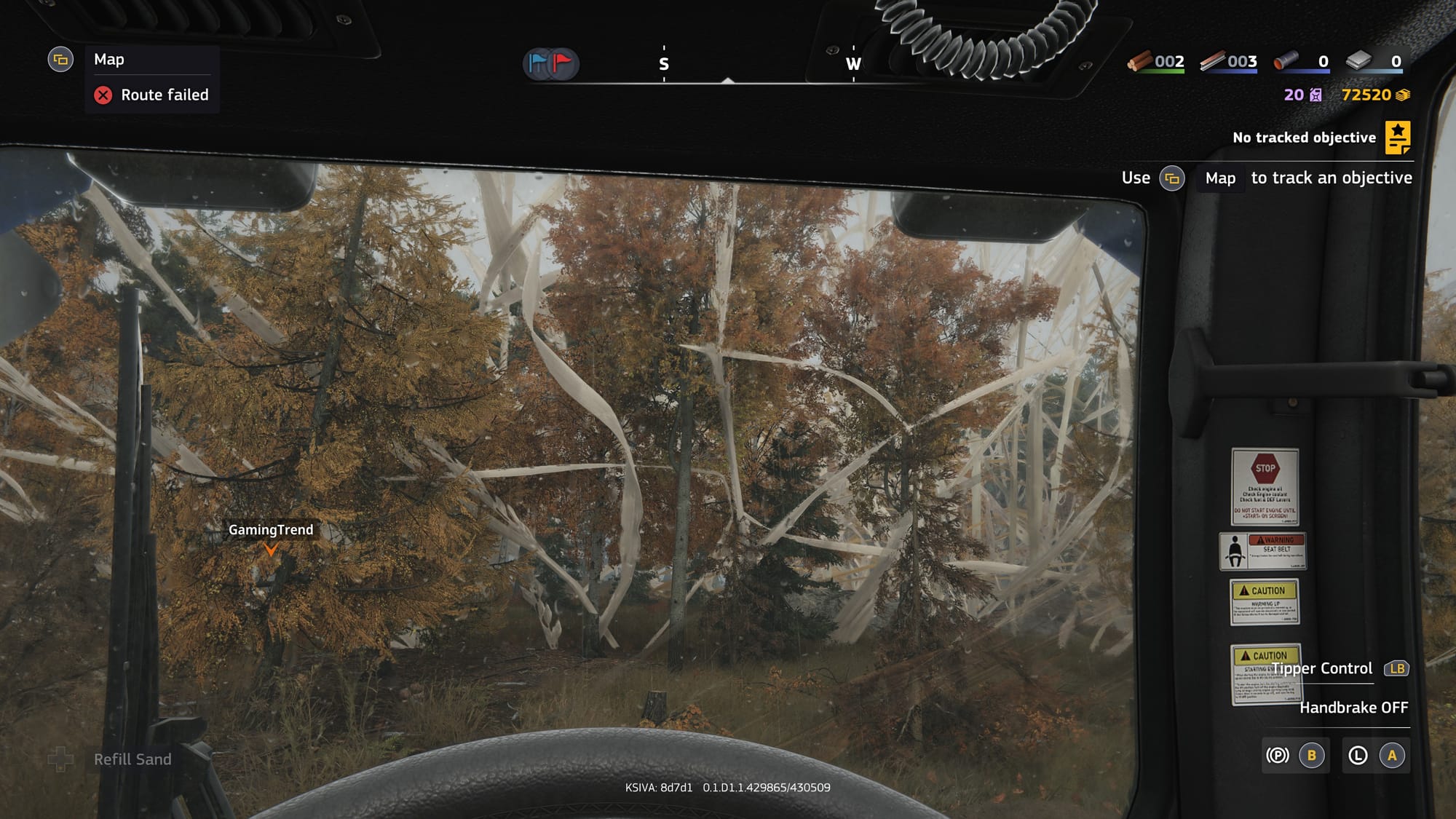
There are a total of eight maps at launch, with more on the horizon. These eight maps each measure about 4 kilometers in size, making them absolutely massive. Add in that it’s not always consistent how you navigate through the map, with large swaths being underwater, stuck in mud, or otherwise restricted with some disaster, and that 4 km gets a whole lot bigger. How you approach the maps is mostly freeform, though occasionally you’ll find there’s only one viable path to accomplish a thing. These sandboxes serve as your progression, appearing to allow you a decision on how you proceed. This is an illusion as you’ll need to accomplish all connected missions to progress to the next. You don’t have to complete every side mission, though doing so will obviously line your pockets and earn more stars towards unlocking vehicles that can help. The UZ 303 "Karelian" and Vostok ETV-89 are both real game changers, almost immune to being stuck and able to move around the map quickly to accomplish your objectives. Not every vehicle is as useful or consistent, but discovering these on your own is part of the challenge. Each one has their purpose, but finding that purpose can be a difficulty in and of itself. These maps are your playground, and how you approach them is up to you. Revisiting them with a new set of vehicles can open up new approaches. It provides some replayability that I didn’t expect.

ALL of these things being said, there are moments where you decide to figure out just how many cargo containers you can stack on top of each other and still have a driveable vehicle that leads to some real laugh out loud moments. Similarly, while the game does have some janky bits, having two, three, or four players splitting up the work and teaming up makes it very easy to overlook much of it. So why is this a “review in progress?” Well, to put it simply, the game is nearly done, and I’d hate to penalize it for what looks to be a temporary launch situation. Since Metacritic does not allow anyone to change their score after the fact (right, wrong, or otherwise), we held onto our score to see a few patches come through. In the mean time, this happened:

You don't typically play 130 hours (and counting) of a game you don't enjoy. Yes, there are some completely aggravating moments, but there is so much to enjoy that it's hard to ignore. As my wife and I complete the last map currently available, we paid the best complement we could to RoadCraft – we looked at their previous game, SnowRunner. It gave me a sense of relief when I saw four years of content – easily over 1000 hours of gameplay. The community mod support, the huge list of maps, and over 35,000 reviews putting it in the Very Positive category on Steam tells me that the things we're experiencing will be patched in the days ahead. Because of that, I can enthusiastically recommend the game, even now. Sure, not everything slips into gear perfectly right now, but by the time you've sank in 100+ hours, you kinda stop caring as much – you'll be too busy having fun.
RoadCraft
Great
RoadCraft delivers an excellent sandbox reconstruction simulation engine that manages to deliver over 100 hours of quality fun, even if there are a handful of occasionally-hilarious bugs at launch.
Pros
- Mud simulations are challenging
- Graphically gorgeous
- Runs great on very modest hardware
- A large variety of fun vehicles
- 100+ hours of compelling content
- Great community and dev support
Cons
- Sometimes simulation slips into unrealistic
- Oh boy, the bugs can be frustrating
- Some vehicle crane controls are migraine-inducing
- Vehicles tip far too easily
This review is based on a retail PC copy provided by the publisher.
